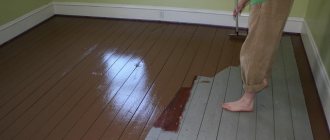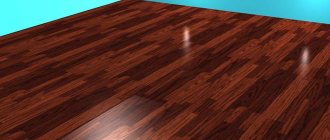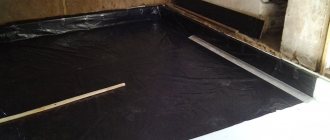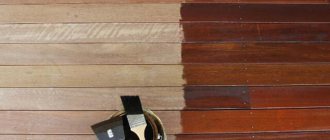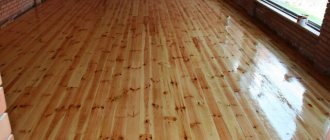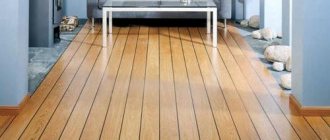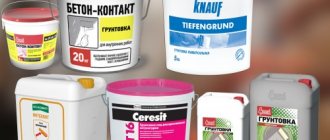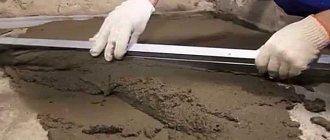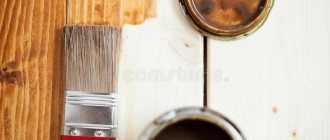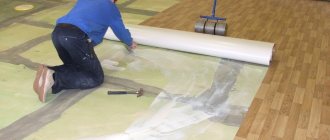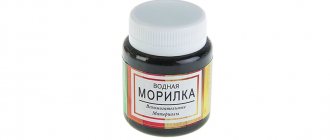Not everyone can afford mahogany or oak parquet. But this is not a reason to deny yourself the contemplation of noble shades. It doesn’t matter what your parquet is made of - tinting will help it “repaint” the most expensive types of wood. For this, there are special tinting compounds - stains, with which you can give wood any color. As a rule, this is the color of a more expensive, elite breed. What tinting liquids are called stains? By what characteristics are they chosen and how are they applied to a wooden surface? Read about all this below.
- 2 Types of stains: selecting the right composition
- 3 Which color should I choose?
- 4 What is the best way to apply stain?
- 5 Preparatory stage: making a color sample
- 6 Surface treatment before work
- 7 Step-by-step dyeing technology
- 8 Video example of working with a solid board
What is stain and why is it needed?
Stain is a tinting liquid that is used to give wood a shade that is not typical for it. Penetrating into the structure of the wood, the stain stains it without forming a film on the surface. In other words, the wood texture remains visible, only its color changes. Due to this, the pine floor can be given a visual resemblance to walnut or oak parquet. Naturally, this similarity will only be external! The remaining characteristics of the rock (resistance to decay, hardness, strength) will remain unchanged.
Preparing the surface for applying stain
Painting with stain is practically the final stage in the production of wooden products, so it can only be started after mechanical processing, incl. decorative (polishing, brushing, sharpening, etc.), completely completed.
The wood should not have any contaminants, even invisible ones (for example, grease stains); during processing they will instantly “appear.” It is not allowed to paint wood with a moisture content above 12-14%, especially those based on nitro compounds and oil.
Painting with stain with a brush
Types of stains: selecting the right composition
Modern stain impregnations can be completely different in composition. Depending on the “content”, they are divided into:
- aquatic;
- alcohol;
- oil;
- nitromordants.
Let's take a closer look at each option.
1. Water-based stains are the most common; they allow you to paint wood in any tone: from the lightest “pine” shade to dark mahogany. Such stains are sold in two forms: liquid and dry. Liquid water stains are ready to use immediately, while dry powders require preliminary dilution with warm water.
Water stains have virtually no odor and this is a huge plus when it is necessary to stain wood indoors. But they take a long time to dry - about 12-14 hours. In addition, water-based stains have the ability to raise the wood pile during the painting process, which leads to the need for subsequent sanding.
Among water-based stains, acrylic stains, made on the basis of acrylic resins, are a separate group. They are resistant to fading and are not washed out by water, raising wood fibers less. Their disadvantage is their high price.
2. Alcohol stains are solutions of various aniline dyes in alcohol (denatured alcohol). After applying the stain, the coloring pigments quickly penetrate the wood texture, and the alcohol evaporates. The alcohol stain dries completely in 15-30 minutes. Therefore, it must be applied quickly to avoid stains and washouts. Uniform coloring using alcohol stain is obtained by spraying it from a spray gun.
3. Nitro stains – solvent-based stains. In their specificity, they are similar to alcohol stains. Requires quick application, preferably using sprayers.
4. Oil stains - solutions of dyes in oil (most often linseed). They apply evenly and easily and do not lift fibers. The coloring pigments of oil stains have high light resistance, so surfaces painted with them do not change their brightness for many years and retain their original appearance.
When applying oil stain, you can use a spray gun, a wide brush, or a rag. Drying of oil stains usually takes 2-4 hours.
All wood stains are divided into types depending on the base on which they are made
- Water-based wood stains;
- Alcohol-based wood stains;
- Nitro stains for wood;
- Oil stains for wood;
- Wax stains for wood.
Water-based wood stains.
As the name suggests, the basis of this type of stain is water. Water-based stain can be sold either ready-made or in the form of a powder that is dissolved in water. This stain is easy to work with, it is very easy to apply and dries quickly. The only, but significant, disadvantage of water-based wood stain is its ability to lift wood fibers. This is due to the fact that wood, when saturated with water, swells and its fibers rise. This feature disrupts the appearance of the material. To avoid this phenomenon, before starting to treat the wood with stain, you should moisten it with water and leave it for a while, after which, when the fibers rise, sand the surface, and only after that start processing with stain. The color range of such stains consists of colors close to natural wood, from light tones to the color of mahogany and wenge.
Alcohol-based wood stains.
Alcohol-based wood stains consist of a dye or tinting component dissolved in alcohol. Such stains are sold, just like water-based stains, in the form of a ready-made solution or powder. If you choose powder, be careful, alcohol-based stain is only diluted with 96% alcohol. If you are not sure that the alcohol you purchased is exactly 96%, it is better to choose a stain in a ready-made solution. A feature of this type of stain is its short drying time. Alcohol stains dry out very quickly, so you need to be very careful when using them. If, while staining the surface using alcohol stain, you are distracted or make incorrect strokes, stains may remain on the surface that are quite difficult to remove or tint.
Nitro stains for wood.
This type of wood stain is made on a solvent basis. Nitro stains, like alcohol stains, dry very quickly, which makes treating large surfaces very problematic, and they also have a strong and unpleasant odor, which limits the possibility of using them indoors. Nitro stains are best used for staining small surfaces, such as doors, windows, and small decorative elements.
Oil stains for wood.
Oil stains for wood are the most versatile and frequently used type of wood stain. The composition includes oils and oil-soluble coloring components. Oil-based wood stain is easy to apply, goes on smoothly, dries quickly enough, but at the same time makes it possible to cover the surface evenly and without streaks. Oil stains for wood are environmentally friendly, odorless, and can be used both outdoors and indoors. Oil stains, unlike others, have not only a decorative, but also a protective function for wood. Oil, penetrating into the upper layers of wood, protects it from dampness, moisture and other atmospheric phenomena. The color range of oil stains is very wide, here you can choose a color and shade to suit every taste and for any interior.
Wax stains for wood.
Wax stains are one of the modern construction developments. When applying this type of stain, a protective film of wax is created on the surface, which creates effective and thorough protection from moisture.
When choosing wood stains, it is important to consider the following factors:
- Tree species. Different types of wood respond differently to staining. For example, wood species that contain resins (pine, etc.) become stained when treated with stains, since the stain does not penetrate well into the areas where the resin is concentrated.
- Specifics of wood use. If you are going to stain wooden dishes or, for example, children's toys, it is better to use oil or wax stains; they are safe for health and do not have an unpleasant odor.
Which color should I choose?
Each stain color according to the international classification has its own code. And the name corresponding to the type of wood, the color of which is imitated by the stain. For example, “Mahogany”, “Oak” or “Plum” stain. But choosing impregnation only by name or picture on the label is unwise. You can get unpredictable results. There are reasons for this:
- The colors of stains of the same code, but from different manufacturers, can differ significantly in shades. For example, the water stain “Larch” has a pinkish-brown color, and the same “Larch” differs from “Novbytkhim” in a soft yellow tint. Many stores display sample dies painted with different stains. Samples will more accurately convey the actual color of the stain than the picture on the label.
- The appearance of painted wood is significantly influenced by its characteristics - natural color, density, structure. For example, stain on mahogany will look darker than on maple (provided the same tone of stain is used). This is due to the fact that mahogany wood itself is a darker shade.
The same experiment with maple and pine samples will show that pine wood stains more intensely and faster. Pine is softer and more porous, while maple is dense and hard. Therefore, it is easier for coloring pigments to penetrate into pine wood.
The degree of staining also depends on the texture of the wood. Oak with a pronounced texture quickly darkens from staining due to the fact that coloring pigments penetrate into the recesses of the veins. The main part of oak wood (outside the veins) stains less quickly and intensely.
Wood staining compositions made from coffee, tea and vinegar
Natural stains are good precisely because they are absolutely safe for human health - what bad things can happen from ordinary food products?
So, to give the wood a brown tint, you can do this:
- Brew the tea, let it brew, then strain out the tea leaves. The resulting composition can be impregnated with wood, saturating it with tannins (contained in tea). Depending on the amount of impregnation and the concentration of the brew, you can get many shades of brown.
- Ground coffee beans need to be brewed, infused and strained. Treat the wood with the resulting infusion. The color will be darker than in the previous case, and it depends on the strength of the resulting drink.
- You can add a little soda to the ground coffee - in a ratio of 1:4 (1 part soda to 4 parts ground coffee) and brew it the same way.
Vinegar is useful for giving wood a dark tint. True, you will need not only vinegar, but also small nails or iron filings (stock up if you know a metal turner).
The stain is done like this:
- Nails or shavings must be degreased and filled with vinegar.
- The container should be placed in a dark place and left for up to 7 days - depending on the desired color and concentration of stain.
- Then the wood is impregnated with stain. This process is called “ebonyization” - that is, giving the material a black tint. The method allows you to obtain various shades of black, but it is especially effective when used for staining species like walnut (with a high content of a substance such as tannin).
Using vinegar stain requires caution
What is the best way to apply stain?
To apply stains you can use: a spray gun (with a nozzle size of no more than 1.5 mm), a wide brush (100 mm wide), a foam swab, and rags. If you have a large area to cover, then you should definitely prefer a spray gun. It is also used when using nitro stains and alcohol stains. They dry too quickly, so when applied with brushes or swabs, stains often form on the wooden surface.
Water-based and oil-based stains can be applied well with brushes, swabs and rags. Brushes with natural bristles are more suitable for oil-based stains, while those with synthetic bristles are more suitable for water-soluble stains. The bristles should be strong and not leave behind hairs on the surface.
Fabrics and tampons used for stains can be cotton or foam rubber. They should also not “sprinkle” with lint and threads, which can remain on an already painted surface and reduce the quality of the coating.
Varnish for coating wooden surfaces
Varnishes that are used to coat wood come in several types:
- Alkyd.
- Polyurethane.
- Acrylic.
- Nitrovarnishes.
- Alcohol.
- Oily.
- Parquet with acid hardener.
Alkyd varnishes must be diluted with a solvent . The surface treated with this product is protected from fire and water and does not fade in the sun. Thanks to acrylic varnish, a film is formed that does not allow the wood to wear off and slows down the aging of wood.
Nitrovarnishes, although they dry much faster, however, are not able to withstand the negative effects of ultraviolet radiation and moisture for too long. Polyurethane varnishes are characterized by increased wear resistance and form a durable film on the wooden surface that dries very quickly.
Relatively recently, oil-based varnishes were very popular, but nowadays they are used most often for treating floors. Their main advantage is their low price. Such varnishes must be diluted with drying oil, and they take a very long time to dry. Such a new product as acrylic varnish, which is universal and easy to use .
It is used for both external and internal work. This varnish should be diluted with water, and it does not have a strong odor. With its protective qualities it resembles alkyd varnishes, but is much more economical to use . But alcohol varnishes are used only for the restoration of antique furniture.
Preparing the wooden surface
It is recommended to apply stain and varnish only to smooth and sanded surfaces. Regardless of whether the coating should be painted - new or old, it must be carefully inspected. All detected cracks, seams and knots should be processed and eliminated .
If gaps are also found between the joints and seams, they are sealed with special putty . As soon as it dries, to remove possible unevenness, the putty areas are sanded again using fine sandpaper.
One should take into account the fact that it makes no sense to putty on raw or under-dried wood, much less treat it with stain or varnish it. Such wood begins to deform and the applied layer always becomes unusable.
Preparatory stage: making a color sample
After purchasing the stain, but before starting the actual painting, it is advisable to make a color sample (test paint). It is necessary to understand whether a given stain is suitable for a particular surface, to identify the final color and determine the number of layers of paint required.
To make a color test, use a board that has been treated (sanded, sanded) in the same way as the wooden surface to be painted. Naturally, the type of wood of the sample board should also coincide with the main surface.
The board is covered with stain in one layer. After drying, the second layer is applied to 2/3 of the sample. The third layer paints another 1/3. The dried stain is covered with two layers of varnish. By comparing the color intensity of each part of the sample, choose the number of layers that is most suitable for a particular surface.
To choose the most optimal option, several test colors are often done. To do this, several boards are coated with different stains. Then they make a choice.
Color spectrum
Do-it-yourself - How to do it yourself How to treat a bathhouse
Today, a range of similar products for coating and painting wooden surfaces can satisfy the needs of every customer. Such products allow the craftsman to give the wood almost any color. Recently, black stain has been in demand among specialists, which gives the treated surface the appearance of a black mirror. The technology for applying the black composition requires preliminary polishing of the base.
Shades of gray will help the surface blend harmoniously into the interior of any room. However, the use of this color will be successful only if the walls and interior items in the room are bright. Gray color can cause apathy, and products painted in this color will be lost against the background of the rest of the decoration.
According to psychologists, the most optimal color for a person is green. It evokes positive emotions and is suitable for painting walls and ceilings, as well as furniture and other things.
The blue color gives expressiveness and depth to the processed product. A stain of this color will go well with white and yellow tones.
In addition to multi-colored compounds, there is a colorless impregnation on store shelves, which makes it possible to preserve the natural color of the material.
The final color of the wood depends on the number of layers applied, so experts advise making a final decision only after a test painting. The material for test painting is sanded and cleaned. Next, proceed to applying the first layer of the composition. After it has completely dried, a second layer is applied, but to a smaller area. The third layer is used to process the material on a section of wood that will be even smaller than the space allocated for the two previous layers of stain.
When all areas are completely dry, comparing the results obtained, you can choose the color you like.
Surface treatment before work
Before applying stain, the wood surface must be prepared. They do this in stages:
1. Remove the old coating (if any). To do this, scrape and polish the boards. In addition to removing the old coating, these procedures will level the floor surface.
2. Clean the surface from grease and oil stains by wiping problem areas with a rag soaked in white spirit or gasoline.
3. It is advisable to deresin coniferous species before applying stain. That is, remove resin from the wood structure, which can interfere with the absorption of the stain. Solutions for degumming are prepared according to the following “recipes”:
- 50 g of potassium carbonate and 60 g of soda ash are dissolved in 1 liter of water heated to 60˚C.
- Dissolve 50 g of caustic soda in 1 liter of warm (soft) water. Treat the surface with the resulting 5% soda solution.
- Mix 750 ml of distilled water with 250 g of acetone.
Any of these solutions is generously applied to the boards, preferably in several layers. After half an hour, wipe the surface with a cotton cloth and rinse with warm water.
Dealing with defects
Did the varnish stain go on incorrectly? There are several ways to eliminate defects. Master Class:
A numbness has formed
We cover the area with varnish, which will dissolve the bottom layer. Now we clean the area with a rag. Work must be carried out immediately after the defect is discovered.
If the smudge has dried, soften it with paint thinner. The seal can also be removed with sandpaper or a plane.
Stains
How long did it take to remove the solution, but stains still formed? The problem may be in the wood itself - the wood sometimes absorbs the solution unevenly. In this case, a plane will help. On plywood you will have to remove all the veneer.
A non-aqueous gel impregnation is suitable for recoating. It does not penetrate deep into the wood, lays down evenly and dries for a long time. Its consumption is reduced due to surface distribution.
A material such as wood has always been in demand, since it is a natural material and no newfangled plastics can compete with it in the ability to create an atmosphere of comfort and warmth in a room. But, like any other material, wooden products require protection and care.
For these purposes, special stains and varnishes are used. Treating wood with such means not only protects it from excessive exposure to light, moisture, scratches, and dirt, but also gives it nobility and sophistication.
To better protect the wood flooring and extend its service life, it is recommended to treat it with stain. This impregnation penetrates deeply into the pores of the wood and enters into a chemical reaction with tannins located in the growth rings, giving the wood a light- and water-resistant color.
In addition, stain protects the wood
from borer beetles, mold fungi and other infections and pests. Modern liquid stains come in the following types:
- oil;
- alcohol;
- aquatic.
Let us consider their characteristic properties in more detail.
Water stain
This impregnation comes in two types: in the form of ready-made solutions that can be used immediately, and in powder form. A solution should be prepared from it. Water stain does not require drying oil
, white spirit and other solvents.
However, it has one significant drawback: when the impregnation penetrates into the wood, it lifts its fibers
, as a result of which the tree remains unprotected from excess moisture.
But, on the other hand, with the help of such wood processing, its structure is emphasized and highlighted. Therefore, today this type of stain is considered the most common.
Alcohol stain
This impregnation is a solution of aniline dye in ethyl alcohol. It is used for decorative and antiseptic painting.
wood products. With the help of alcohol stain, pile lifting is reduced and wood swelling does not occur.
Using this type of stain, it is quite difficult to achieve uniform coloring, because the composition dries very quickly and stains can form
. This impregnation is best suited for tinting small products, but it will not be suitable for painting parquet.
Oil stain
This impregnation is a dye dissolved in flax oil. It is the most convenient to work with and can be applied in different ways. Oil stain does not lift fibers and is evenly distributed over the entire wooden surface. Products processed in this way can always be easily repainted and restored.
Step-by-step dyeing technology
Despite the multiple preparatory steps, the direct process of applying stain is not at all complicated. It is performed according to the following scheme:
1. The stain is heated a little to increase the degree of penetration into the wood.
2. A swab, rag or brush is soaked in stain. Strong moisture should not be allowed, otherwise drips and uneven coloring will inevitably occur. When using a sprayer, pour the stain into the tank.
3. Apply stain along the wood fibers. They try to work quickly, without interruptions, to avoid stains. When streaks form, wipe the surface with a soft cloth, “pulling” excess liquid along the fibers. Leave the stain until completely dry.
4. In a similar way, apply several more layers to obtain the desired shade (usually 2-3 layers).
5. Finally, the stain-painted surface is varnished in several layers, sanding each intermediate layer with fine-grained sandpaper.
Defects and their elimination
Staining wooden furniture must be done extremely carefully, otherwise there is a high risk of defects forming that are quite difficult to eliminate. But if you know how to get rid of them correctly, then there shouldn’t be any problems.
The main defect is the formation of streaks. They arise as a result of applying a large amount of the mixture and its subsequent rapid drying. In this case, it is necessary to remove the layer of impregnation applied to the wood, then apply a new layer on it, which will soften it, and then remove excess impregnation with a rag.
After the wood stain has completely dried, it can be removed using paint solvents. Before this, the top layer is removed with sandpaper or a plane, since the solvent is not able to remove all the pigment.
The most difficult defect is spotting of the product. To remove it, the painted area is treated with a plane (this defect is not washed off with a solvent). In plywood, all face veneer must be removed. To avoid staining, it is better to use a gel stain or first apply a test layer on an unwanted piece of wood to see how the coating behaves on the desired surface. It is worth remembering that the impregnation must be stored in a place away from children.
Today there is such a variety of wood impregnating agents on sale that even a specialized specialist cannot clearly answer the question of what their fundamental difference is. If you read the instructions for the preparations, the conclusion suggests itself that most of them protect wood literally “from everything.” So why do you need wood stain? Is it only for toning it, as is commonly believed?
An analysis of all the properties of the preparations available on the market in this category for wood processing, and reviews on thematic sites allows us to determine exactly what can be achieved with their help. Depending on the composition and specific application, wood stains can solve the following problems:
- Wood tinting while maintaining its texture.
- Reliable protection of the material when other means are ineffective or their use is not economically feasible. Reasoning - stains are characterized by a greater depth of penetration, while being cheaper than paints, varnishes and a number of other preparations used for wood processing (at least 2.5 times).
- Imitation of another, more expensive breed.
- Wood bleaching. This is often done either during its restoration, or in preparation for painting (applying colored varnish).
- Protecting the material from rotting (antiseptic function) and destruction by wood-boring insects.
- Combining shades, creating the effect of surface finishing with different woods.
- Some stains strengthen its structure.
- Giving (partial) moisture-repellent properties to lumber.
- Any stain, regardless of composition, definitely increases the shelf life of wood.
But is it really that simple? Is it enough to buy any of the commercially available stains, and all problems with reliable wood processing are solved? A comprehensive answer can be obtained by familiarizing yourself with all the types of liquids in this group. By the way, stains are often called differently - stains - and they are used not only to protect and prepare for further use of natural wood, but also building materials based on it (plywood, MDF, fiberboard, OSB, chipboard).
Selecting the desired shade
The opportunity to experiment with shades opens up broad prospects for the implementation of the most daring design projects. Today in the TBM-Market store you can inexpensively buy ready-to-use stain in dark and light tones to match the color of oak, alder, walnut and others. But on products made from different types of wood, the same type of stain can look different. The result depends on the structure and density of the wood, its chemical composition. That is why, after purchasing, the material should be tested on invisible areas of the surface to be treated or on a separate board.
Test painting is an important point that helps you choose the right color and shade of the coating. What's the best way to do it? The easiest way is to compare:
- First, the first layer of stain should be applied to the board chosen as a sample.
- After waiting for complete drying, cover 2/3 of the board with a second layer.
- Then, according to the same scenario, paint 1/3 for the third time.
This way you can see the difference in color intensity with different numbers of layers and choose the appropriate option. This method often comes to the rescue when furniture or room decoration is combined from different materials, for example, solid wood and plywood.
Solid pieces of wood look darker after staining, so more layers will have to be applied to the plywood parts to even out the color. Deciduous wood absorbs more coloring composition, coniferous wood absorbs less.
A skillful combination of shades allows you to realize any creative fantasies. Using the right tones, you can give a rich mahogany look to products made from birch, ash, pear, linden and alder. The same wood is ideal for imitation walnut.
In the specialized store "TBM-Market" you can choose your preferred stain shade from the catalog and evaluate the result of the future finishing from the photo.
Tips for choosing
A separate category consists of impregnations, which are necessary to improve the structure and durability of wooden elements.
Such mixtures include:
- Drying oil. It is applied to protect the base from any harmful influences. It is better to lay several layers to achieve deep penetration. Can be used before oil paints to reduce their consumption.
Drying oil Oxol consists of 55% natural oil component, 40% white spirit, 5% drying agent, therefore, compared to natural drying oil, its cost is lower and it dries faster
- Oil. Parts that are close to the ground or immersed in it are processed.
The oil is ideal for processing wood indoors with temperature changes and high humidity.
- Special antiseptics. Protect from microorganisms and insects, prevent rotting.
Universal deep-penetrating colorless antiseptic for wood Neomid
- Fire retardants. Do not allow the fire to spread quickly.
Fire-retardant composition for wood Phenilax
Stains can also be classified according to their intended purpose - products for interior use and compositions for exterior use. The main and only criterion for their difference is the presence of a pigment in the composition of outdoor products, which provides protection against fading.
When choosing products, it would be useful to decide on the tool that will be used to treat the surface with the purchased composition. There are stains that are applied to a wooden surface with a brush; for some, you may need a spray gun.
For interior work, for example, if processing of furniture is required, it is better to give preference to wax or oil compounds. They contain almost no volatile compounds. Almost all stains are compatible with paint varnishes.
Alcohol-based products have their own characteristics. They are ideal for tinting furniture, wood products or doors. And for stairs or parquet, you should choose a different type of stain. Alcohol compositions must be applied to the surface with a spray gun, since any error or delay in work will be fraught with the formation of a stain, as a result of which repair or construction work will have to start all over again.
Powdered alcohol products need to be diluted with only 96% alcohol. But there is no guarantee that the purchased alcohol will meet these requirements. Therefore, it is worth buying a ready-to-use liquid composition. This will help to avoid troubles associated with repairs, construction or restoration work.
Oil or wax based stains are more expensive than other types. But the method of applying them to the material can be any. It is recommended to carry out restoration work with this type of wood treatment product, since it is absolutely safe for human health due to its environmentally friendly composition.
Features of the composition for painting
Whether you need to repair old doors or give new ones a different look, choosing the right paint product is very important. The quality and service life of a wooden door depends on it. Let's look at the most common means.
Varnishes – colored, glossy or matte. Their main property is that the structure of the wood will definitely be visible under the layer of substance. If you have completely restored the door, then varnishing is unlikely to be suitable, since all the defects and subtleties of processing will be visible. There are several varnish options:
- oil based;
- alcohol varnish;
- polyurethane;
- solvent-based nitrovarnish.
The latter type is not suitable for use on wood: the composition of this varnish has a bad effect on wood. But polyurethane varnish is durable and resistant to mechanical damage, so it is perfect for our task, although it is quite expensive.
The choice of varnish or paint depends on the type of door and its location in the room
If painting with varnish is not suitable for you, turn to paints. Their choice on the modern market is huge both in color and composition, and it will not be difficult for you to give the door any look. Paints can be matte, glossy or emphasizing the wood structure
The main thing is to pay attention to what base the product is made of - oil or alcohol. Nitro paint is also suitable
There are also oils containing wax intended for painting wooden surfaces. This product can be transparent or colored; it will give the wood a soft silky feel. The disadvantage of this material is its high cost.
Compositions for different types of doors
When choosing a paint product, pay attention to the condition of the door leaf. As already mentioned, for an old door that had to be restored, a varnish coating under which the entire surface is visible is absolutely not suitable
In this case, it is better to use paint. The varnish will look good on the new door.
The modern market offers a large selection of paints and varnishes for wooden doors
There are 2 types of paints and varnishes most often used in such work.
- Acrylic compositions on a water-dispersion basis. They are easy to apply and adhere well, as if covering the surface with a thin layer of plastic. There is no pungent odor when drying.
- Alkyd paints and solvent-based varnishes. When painting, they penetrate deep into the wood structure and dry quickly. They withstand temperature fluctuations and have a water-repellent effect. The disadvantages include a strong odor when drying.
Taking these points into account, we can conclude that acrylic compositions are well suited for interior doors and dry rooms. Alkyd paints are best used on entrance doors or in damp rooms
If you plan to paint the door one color, then the choice of coloring material will be based on the above criteria
But if you have a door leaf with a design, take into account the following:
- matching the color of the floor, wall cladding, furniture;
- antique decor or a certain style - high-tech, country, etc.;
- contrast of individual parts (relevant for paneled models);
- wood structure;
- applied drawing. This diagram will help you choose the type of wood by color
Please note: paints must be applied to a completely dry surface. Otherwise, the paint layer on damp wood will begin to peel and flake off.
Manufacturers: review and reviews
Today, the coatings market offers foreign and domestic products. It is a company that specializes in the production of construction and household chemicals. The range of produced compositions includes various varnishes, paints, decorative materials, as well as stains on different bases.
According to most buyers, wood compositions for processing and painting wooden products have a strong smell, but do an excellent job and also dry quickly. Therefore, painting work must be carried out as quickly as possible. The composition applies quite smoothly, the color is uniform.
The Liberon brand operates as part of the V33 company, an international leader in the production of paintwork materials and products for wooden surfaces. Products of this brand are popular all over the world because they are designed for wood care, as well as for restoration work with antique interior items and furniture.
Consumers note some advantages of Liberon wood products:
- convenience and ease of application of the composition;
- no smell.
The disadvantages of such products include some discrepancy between the declared color and that indicated on the packaging.
The most famous German companies that specialize in the production of wood products are Flamingo, Dufa and Caparol.
Caparol has a separate line of products for protecting wooden surfaces.
No less popular products for caring for and painting wood are the compositions produced by Turkish companies. The leaders among them are manufacturers Betek, Dyo, Marshall.
Specialists who carry out repair work note the high quality of German wood compounds.
Only positive reviews have Turkish products for painting wooden surfaces.
Application methods
There are four main ways to apply stain:
- Rubbing painting. The composition is applied to the surface, after which it is rubbed over the entire area. Recommended for use when processing porous wood species.
- Spraying. When staining wood by spraying, a manual or automatic sprayer is used as a tool for applying stain.
- Processing with a foam roller. This method avoids the formation of streaks and helps to distribute the mixture evenly over the entire surface.
- Processing wood with a paint brush. The method allows you to obtain a deeper and richer color of wood, but is not suitable for all types of impregnation.
Next, we will consider in detail how to stain wood. To obtain a high-quality and good coating, you must follow the basic rules for treating surfaces with stain:
- Before painting a surface with stain, it is necessary to remove old coatings from it, and then degrease it better.
- The surface made of coniferous species (for example, pine) must be deresined.
- It is necessary to paint wood with stain and remove excess only in the direction of the wood structure.
- It is recommended to cover the surface with 2-3 layers, while for the first layer a small volume of the mixture should be used.
- After the first layer has dried, the surface must be sanded and the raised lint removed, and then, if necessary, apply subsequent layers (each subsequent layer is applied only after the previous one has completely dried).
The approximate drying time for oil-based impregnations is about three days, and for water-based and solvent impregnations - 2-3 hours (depending on how many layers were applied). It is recommended to divide large areas of the surface to be treated into small areas and paint them in stages. To avoid the possibility of defects forming on the surface, the composition must be diluted. A solvent is used for this.
Plywood stains perform a purely decorative function. Therefore, if you are in doubt about whether to choose stain or varnish, it is recommended to use them in combination. Before covering the surface of the plywood, it must be moistened, and it is recommended to heat the mixture itself.
After covering the wood with stain, it should be treated with varnish (layers should be very thin to avoid the possibility of smudges). The tool you can use is a brush, roller or sponge. Wood varnish will enhance the protective properties of the impregnation. By following these recommendations, you can easily stain wood at home.
Is it possible to dilute stain with white spirit?
Thinner - a liquid used to dilute stain
, paint or varnish to reduce viscosity.
... For example, white
spirit
can be diluted with
thick alkyd-oil or polyurethane varnish, but after drying these varnishes no longer dissolve in it.
Interesting materials:
What is Tourer V? What is AGM technology? What is a toned body? What are Thermogenics? What is Thermometric Liquid? What is Testosterone Booster? What is a liftback body type? What is fuel injection pump gasoline? What is a diesel injection pump? What are top profiles?
How to make wood impregnation with your own hands
Wood is a very beautiful and durable construction and finishing material. However, without proper care, wood is susceptible to the negative effects of moisture, fungal diseases, mold and insects. If measures are not taken to protect the wood, it will soon not only lose its attractive appearance, but will also be destroyed. To prevent these damages, wood must be regularly impregnated with antiseptic solutions. Penetrating inside, they protect the tree, preserving its structure and properties. Such materials are not cheap, so to save money you can prepare wood impregnation with your own hands.
We'll tell you later how to make wood impregnation with your own hands. Thus, the most common solution for protecting wood is a wax-based material.
Do-it-yourself wax impregnation for wood is very simple:
- First of all, beeswax is grated. It is often sold in shops where they sell honey.
- Then the wax is melted over low heat and a drying oil based on linseed oil is added to it. Do-it-yourself impregnation of wood with oil and wax will reliably protect the wood from moisture. After cooling, the solution will have the consistency of thick grease.
- Apply it to the surface in a thick form. Then, using a hairdryer, the mixture is liquefied and rubbed into the surface of the wood with a rag. After drying, it will reliably protect the wood from moisture.
